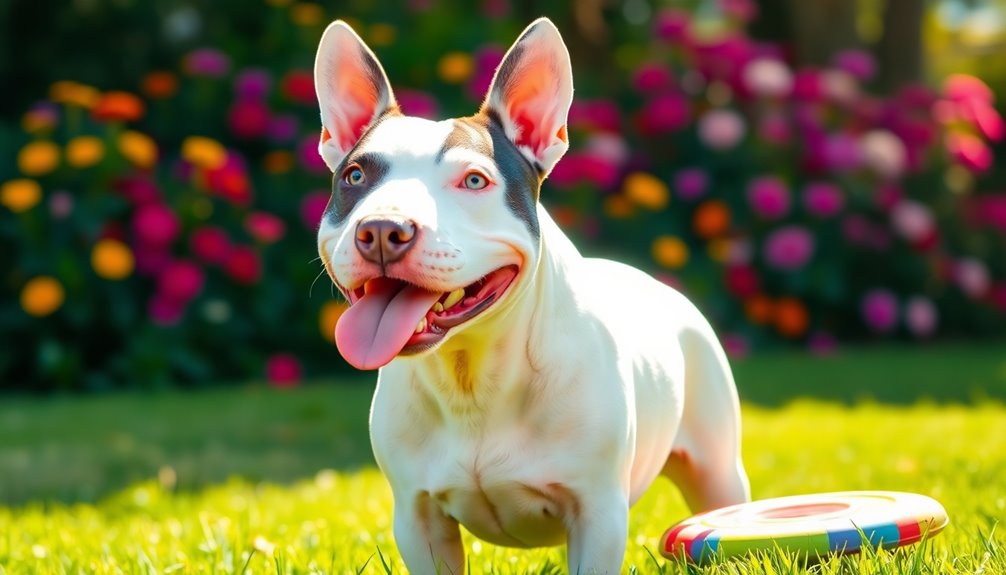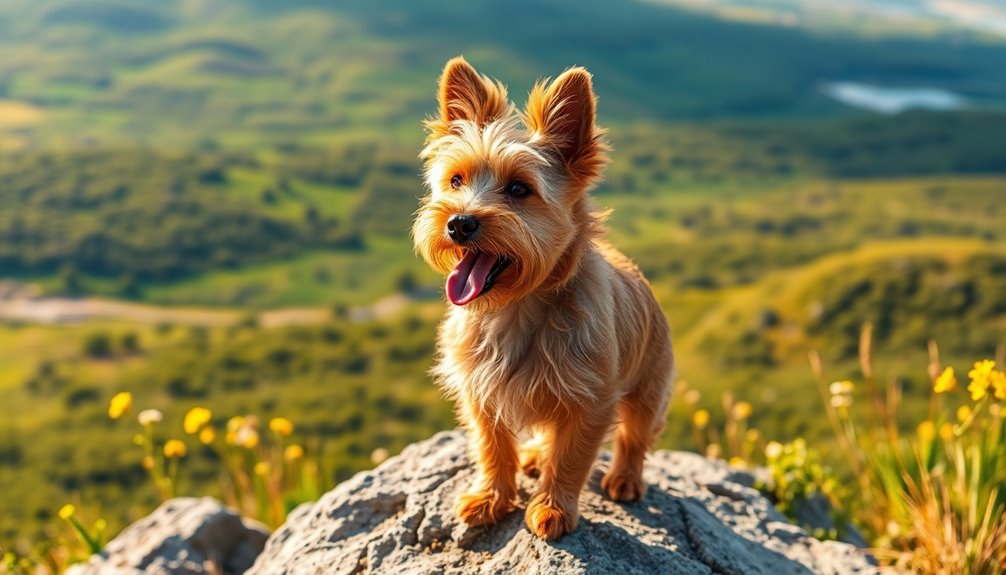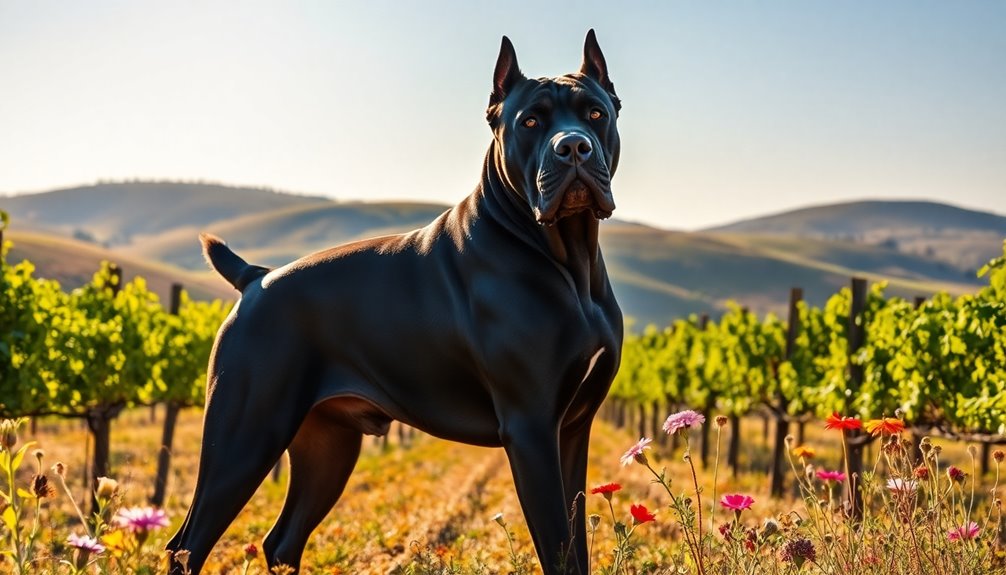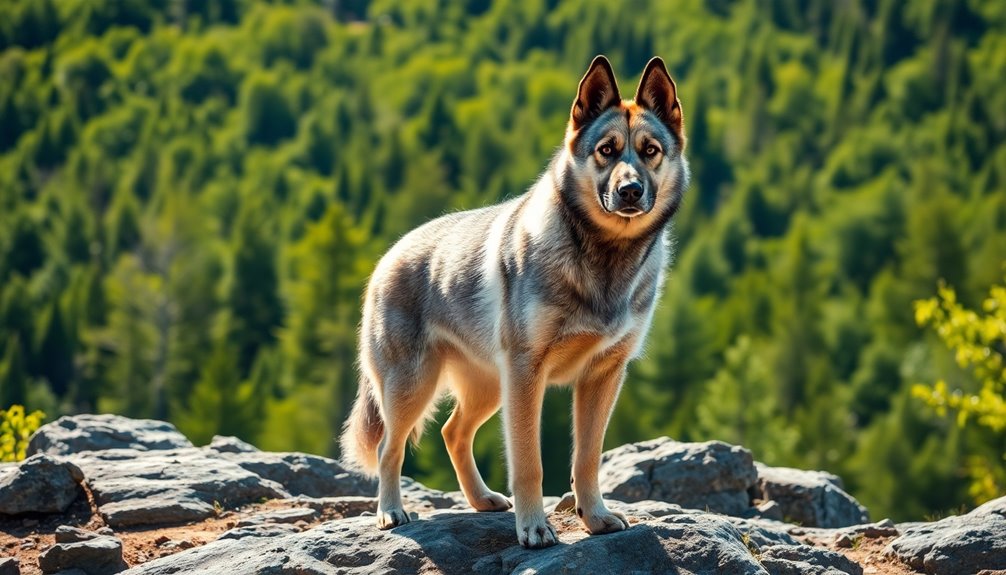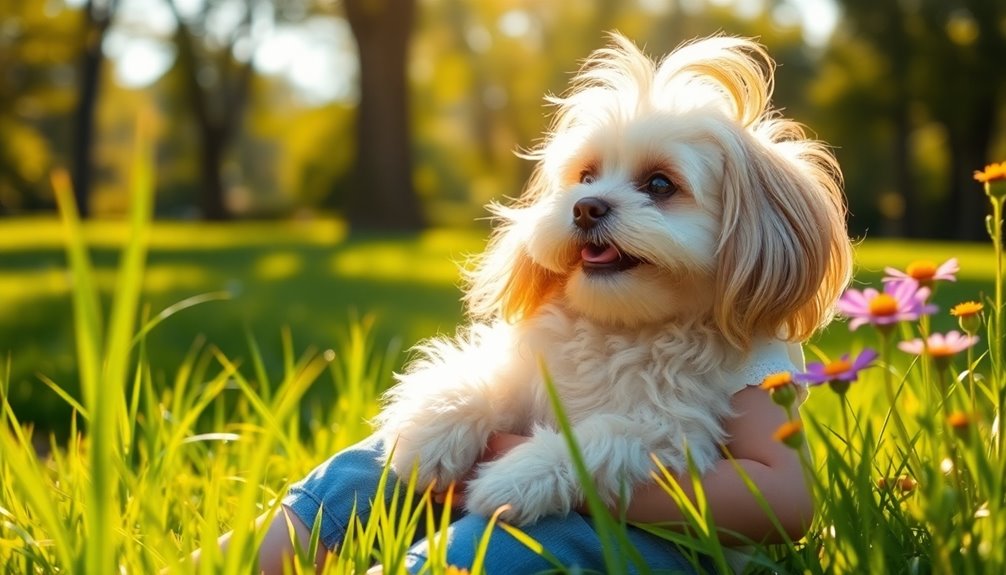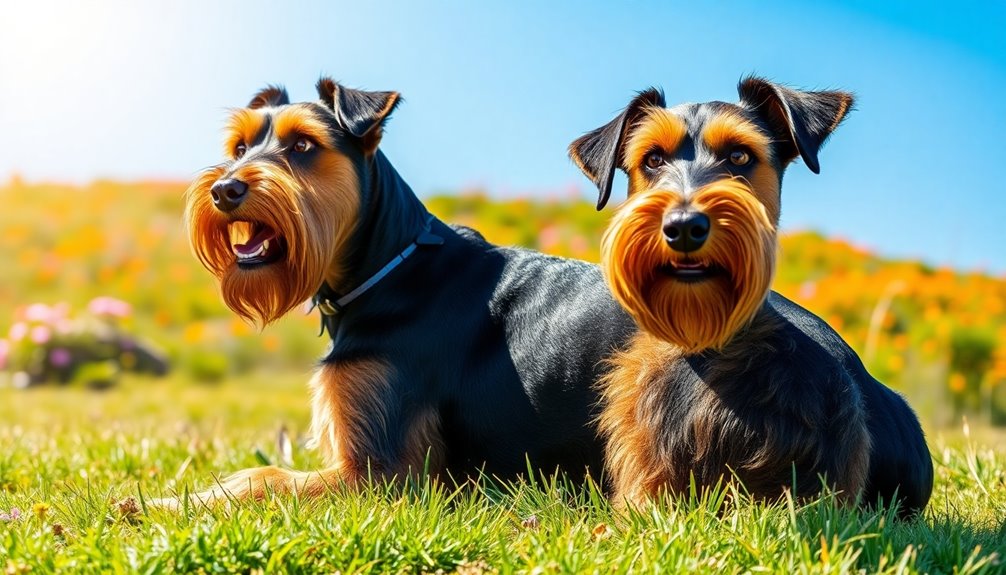You'll discover that the Bull Terrier truly lives up to its nickname as the clown of the canine world. With its unique egg-shaped head and playful nature, this breed brings joy to any household. Originating from England, these dogs have evolved from fierce fighters to loving companions. They're energetic, requiring daily exercise and mental stimulation to keep their spirits high. You'll notice they prefer to communicate through body language rather than barking. Their affectionate demeanor forms strong bonds with families. Stick around, and you'll uncover more about their fascinating traits and how to care for these delightful pups.
Key Takeaways
- Bull Terriers are known for their playful and energetic nature, often engaging in amusing antics that entertain their families.
- Their unique egg-shaped head and expressive body language contribute to their clownish persona, making them visually distinctive and engaging.
- They thrive on companionship and love participating in family activities, often showcasing their playful spirit through humorous behaviors.
- Known for minimal barking, their communication style relies on non-verbal cues, adding to their quirky charm.
- With proper training and socialization, Bull Terriers can harness their playful energy, making them delightful companions and entertainers.
Introduction
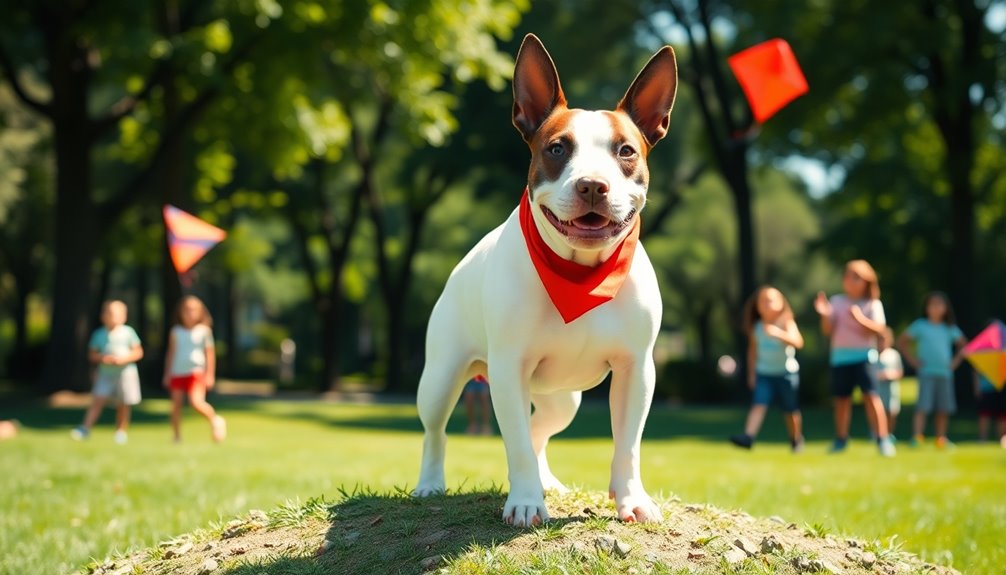
When you think of a dog that's both playful and unique, the Bull Terrier often comes to mind. With their distinctive egg-shaped head and erect ears, they stand out in any crowd. Typically, they weigh between 50 to 70 pounds and reach a height of 21 to 22 inches at the withers. Miniature Bull Terriers are also available, weighing around 24 to 33 pounds, making them a bit more manageable for some owners.
Bull Terriers are known for their active and loyal nature. They're playful, often displaying a clownish personality that can keep you entertained for hours. However, they require moderate social interaction, thriving on human companionship. Additionally, they are not ideal for dog parks due to their potential aggression towards unfamiliar dogs.
While they can be stubborn and mischievous, they're generally gentle with family members, though they might show aggression towards other dogs.
In terms of care, these dogs have a lifespan of 12 to 14 years and need about 40 minutes of exercise daily. Their short coat requires minimal grooming, but you need to be cautious about their feeding to prevent obesity.
Bull Terriers are a delightful mix of energy and charm, making them a memorable addition to the right home.
History and Origin
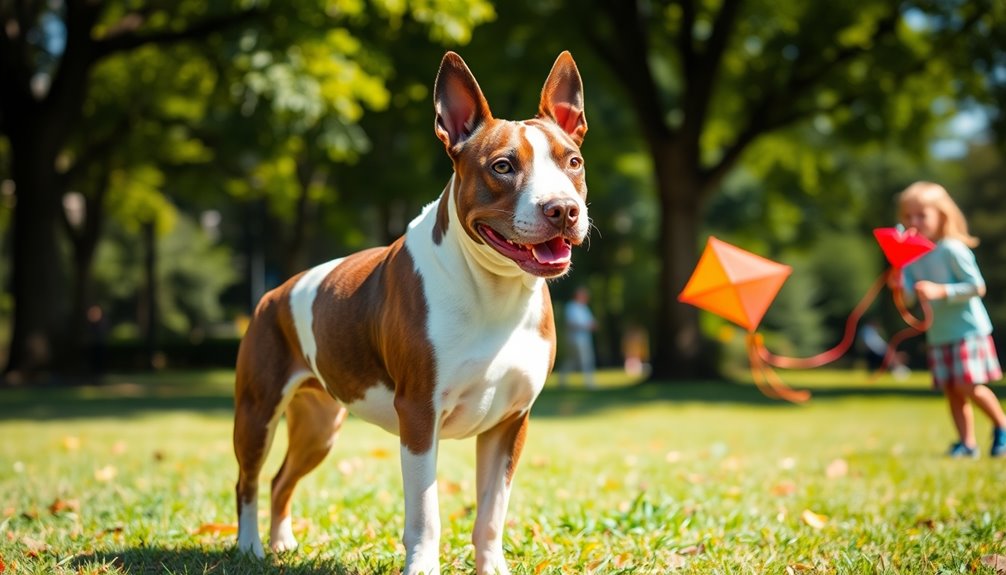
The Bull Terrier originated in early 19th century England, born from a mix of Bulldogs and various terriers.
Initially bred for blood sports like bull-baiting and dog fighting, these dogs showcased a unique combination of strength and agility.
Over time, they evolved into beloved companions, shedding their fighting past for a more playful role in family life. The breed's development involved crosses with various old working terriers, which contributed to their agility and temperament.
Where and when the breed originated
Bull Terriers originated in Great Britain during the mid-Victorian era, a time marked by significant advancements in dog breeding.
You'll find that the breed was developed mainly by English gentlemen and breeders in regions like Birmingham and Ireland. The early 1800s saw initial crossings between bulldogs and terriers, which laid the groundwork for what would become the Bull Terrier.
In the 1850s, James Hinks began the critical process of standardizing the breed. He introduced new bloodlines, potentially including Collies, Dalmatians, and Pointers, which helped refine the Bull Terrier's distinctive features. This development was part of a broader trend of crossbreeding practices that varied geographically, influencing the breed's characteristics.
Hinks's son also played a role in further development, alongside other breeders who contributed to the hybridization of bulldogs and terriers.
Fighting and Ratting Companion
Having evolved from their origins as fierce fighters, Bull Terriers transitioned into valued companions and skilled ratters as blood sports became outlawed in the 19th century.
Initially bred for bull-baiting and dog fighting, these dogs combined the strength of the Old English Bulldog with the agility of various terriers. After bull-baiting was banned in 1835, breeders refined them for dog fighting, but they ultimately found their niche in ratting. The Bull Terrier's adaptability allowed it to serve in various roles, including show dog, therapy dog, and participation in canine sports.
James Hinks played a crucial role in transforming the breed, focusing on their companionship qualities. While they'd once been known as "canine gladiators," their reputation shifted toward that of a gentleman's dog.
Their physical traits evolved, moving from bow legs and undershot bites to a more refined appearance with a level bite.
As ratters, Bull Terriers excelled in hunting, showcasing their prowess in pits. They became popular among upper-class gentlemen and sportsmen, valued not just for their skills but also for their charming, clownish personalities.
These dogs formed strong bonds with their owners, offering unwavering loyalty and affection, marking the end of their fighting days and the beginning of a new legacy.
Physical Characteristics
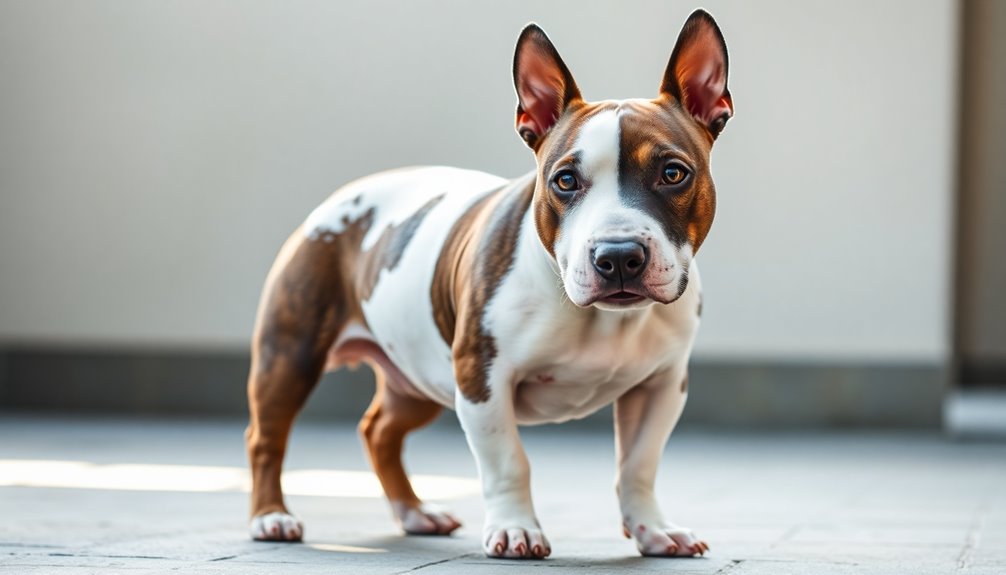
When you look at a Bull Terrier, you'll notice its unique triangular head shape and stocky build. Standing 21 to 22 inches tall and weighing between 50 to 70 pounds, these dogs are strong and muscular for their size. Their short coat comes in a variety of colors, adding to their distinctive appearance. Each coat color, such as brindle and fawn, reflects the breed's vibrant history and genetic diversity.
Size, weight, and coat details
Stepping into the world of Bull Terriers reveals their impressive physical characteristics, which make them stand out among dog breeds.
These medium to large-sized dogs typically stand 21-22 inches tall at the shoulder for males and 19-21 inches for females. By the age of two, males can reach heights of up to 24 inches, while females may reach 23 inches. Males usually weigh between 70-85 pounds, and females average 60-80 pounds. Their growth pattern demonstrates that they typically reach their full height by 12-14 months.
Their muscular build showcases a compact yet strong body with a broad chest and powerful legs. This structure gives them impressive agility and endurance, making them one of the strongest breeds for their size.
Their short, flat coat can come in various colors, including brindle, red, fawn, and black, or even all white. While they do shed seasonally, their grooming needs are minimal; a weekly brushing will keep their coat healthy and free of loose hair.
With a blend of power and energetic nature, Bull Terriers thrive on daily exercise, ensuring they stay happy and healthy.
These physical traits not only define their appearance but also contribute to their lively, clownish personalities.
Unique Triangular Head Shape
Bull Terriers often captivate attention with their unique triangular head shape, which is one of their most distinctive physical characteristics. When you look at a Bull Terrier from the front, you'll notice that its head appears egg-shaped. The skull and face are almost flat, curving gently down from the top of the skull to the tip of the nose. This unique profile, combined with a flat forehead, gives the breed an intelligent appearance.
The small, dark, deep-set triangular eyes contribute significantly to their alert expression. These well-sunken eyes are set high on the head and are spaced closely together, enhancing their "varminty" look. You'll find that blue eyes are disqualified in the breed, emphasizing the importance of the traditional eye structure.
Originally bred for dogfighting, this head shape was designed to make it harder for opponents to grab the dog. Even after the end of dogfighting, selective breeding has preserved this iconic trait. Interestingly, health issues such as a 20.4% incidence of deafness are prevalent in pure white Bull Terriers, highlighting the significance of this breed's genetics.
The combination of the head's structure, including its eyes and ears, enhances the Bull Terrier's outgoing and spirited demeanor, solidifying their status as the clowns of the canine world.
Temperament and Personality
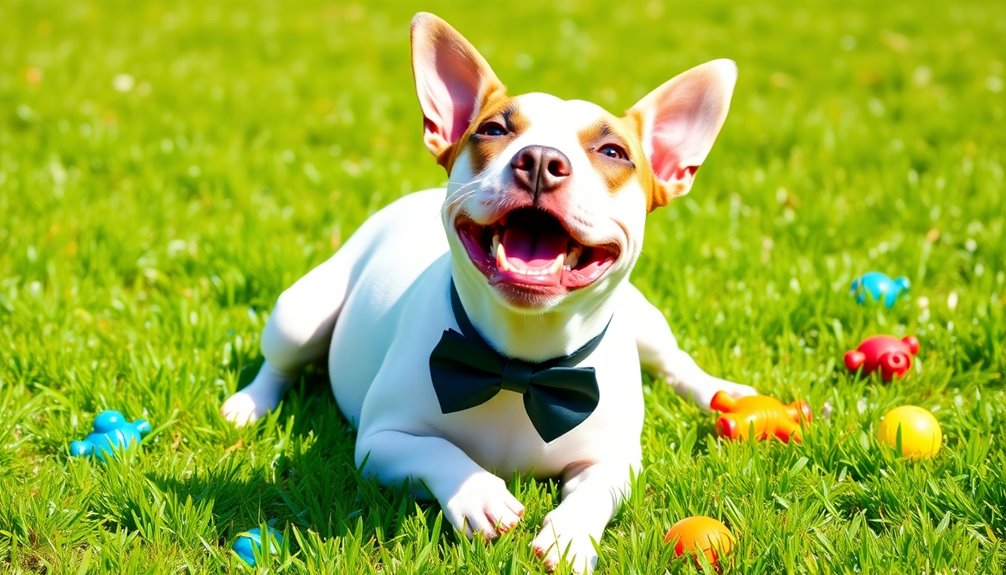
When it comes to temperament, Bull Terriers are the playful clowns of the canine world, always ready to entertain with their mischievous antics. Their energetic nature makes them a great fit for families, individuals, or even other pets, as they thrive on companionship and love to be part of the action. Just keep in mind that their spirited personality requires proper training and socialization to ensure they shine in any environment. To maintain their high energy levels, they need regular exercise and mental stimulation to prevent boredom.
Playful and Mischievous Nature
With an abundance of energy and a playful spirit, Bull Terriers bring a delightful mix of fun and mischief to any household. These dogs thrive on action; they can't stand being inactive or left alone for long periods. Their energetic nature makes them perfect candidates for dog sports, and they're always eager to engage in high-energy playtime.
Their mischievous nature means they often get into trouble, showcasing their clownish behavior through entertaining antics. You might catch them displaying goofy and droll actions that can keep you chuckling. However, without proper training, they can develop unconstructive habits like excessive barking or chewing.
Bull Terriers are social creatures that love to be around people, making friendly overtures to both adults and kids alike. Their courageous spirit and fun-loving attitude shine through in every interaction. To help them flourish, early socialization is key for ensuring they get along with other pets.
Suitability for families, individuals, or other pets
Understanding a Bull Terrier's temperament and personality is essential for determining their suitability for families, individuals, or other pets. These dogs are incredibly affectionate and loyal, making them great companions for families, especially those with older children.
Their energy levels require daily physical and mental stimulation, so if you're active, you'll enjoy their playful nature. Regular stimulation through social interaction helps maintain positive behavior in Bull Terriers.
For singles, Bull Terriers crave companionship and bond deeply with their owners. Their intelligence makes them trainable, but be prepared for their stubborn streak. Consistent, positive reinforcement is key to managing their independent behavior.
When it comes to other pets, early socialization is crucial. While they can generally get along with other animals, their high prey drive means you'll need to ensure they're leashed around smaller pets.
With proper training, they boast a compatibility rating of 4 out of 5 with other animals, but without it, they might show aggression.
Ultimately, whether you're a family, an individual, or have other pets, a Bull Terrier can fit in beautifully with the right training and socialization. Just be ready for their spirited antics and protective instincts!
Health and Lifespan
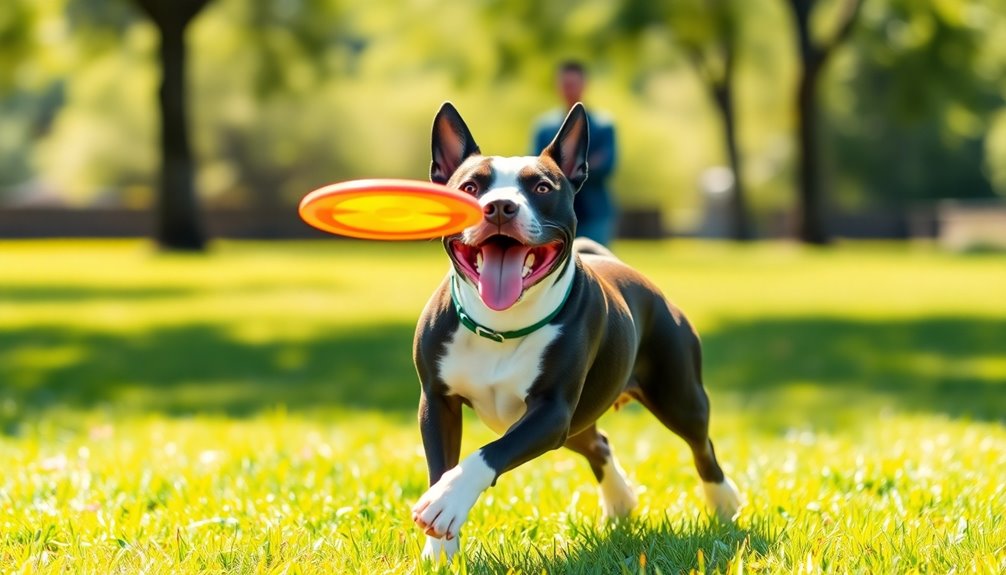
When it comes to health and lifespan, Bull Terriers generally live between 10 to 14 years, but with proper care, they can thrive even longer.
You should be aware of common health issues like hereditary nephritis and deafness, especially in white Bull Terriers.
To keep your furry friend healthy, focus on a balanced diet, regular vet visits, and plenty of exercise. Additionally, being aware of hereditary conditions can aid in preventive care and selecting a reputable breeder can help reduce health risks.
Typical lifespan of the breed
The Bull Terrier, known for its playful and energetic nature, typically enjoys a lifespan ranging from 11 to 14 years. This puts them slightly above the average for medium-sized dogs. With proper care, some Bull Terriers can live up to the 14-year mark, but studies show that the median lifespan is around 10 years, with UK averages at approximately 9 years.
Several factors influence their lifespan. Genetics play a significant role, so choosing a reputable breeder is essential. Your dog's environment, including exposure to extreme temperatures, and the level of care you provide—such as a balanced diet, regular exercise, and routine veterinary check-ups—can also impact longevity. Routine veterinary check-ups are essential for monitoring health and catching issues early.
Socialization and mental stimulation are crucial, helping keep your Bull Terrier happy and engaged throughout their life. During different life stages, from puppyhood to mature adulthood, meeting their nutritional and exercise needs is vital.
Regular veterinary visits and preventive healthcare measures, like vaccinations, can help catch any potential issues early. Creating a loving and stable home environment ensures your Bull Terrier thrives, maximizing the years you have together.
Common health concerns or genetic predispositions
Despite their lively and affectionate nature, Bull Terriers can face several health concerns that impact their lifespan. One significant issue is Lethal Acrodermatitis (LAD), an inherited condition that leads to poor growth, immune deficiencies, and painful skin lesions. Puppies with LAD often have a drastically reduced lifespan due to complications from infections. Genetic testing for Lethal Acrodermatitis (LAD) can help identify carriers and affected dogs, allowing for informed breeding decisions.
Respiratory problems like laryngeal paralysis can also arise, making breathing difficult, especially during exercise. This condition can become fatal if untreated. Regular veterinary check-ups are essential for early detection and management.
Cardiac health is another area of concern. Bull Terriers are prone to heart conditions, so annual screenings are crucial to catch any issues early.
Additionally, genetic predispositions to deafness, kidney disease, hip dysplasia, and thyroid problems exist within the breed. For example, around 20% of pure white Bull Terriers may suffer from heritable deafness.
To ensure your Bull Terrier lives a long, healthy life, stay informed about these potential health issues and seek guidance from your veterinarian on preventative measures and testing.
Tips for maintaining health and wellness
To keep your Bull Terrier healthy and thriving, a proactive approach to their care is essential. Regular veterinary check-ups are crucial for early detection of health issues specific to the breed, like deafness, allergies, and kidney problems. Aim for annual or bi-annual visits to ensure vaccinations and screenings are up to date. Additionally, genetic testing can help identify predispositions to certain conditions, allowing for more targeted care.
A balanced diet plays a vital role in your dog's health. Choose high-quality dog food tailored to their needs, ensuring they get the right mix of carbohydrates, protein, and healthy fats. Avoid overfeeding by sticking to 1.5 to 2.5 cups of food daily to prevent obesity.
Exercise is key for your Bull Terrier's well-being. Provide at least 30-60 minutes of physical activity each day, including walks, runs, and agility training to burn off excess energy. Make sure to vary the routine to keep things interesting.
Finally, don't forget about mental stimulation and grooming. Engage your dog with puzzle toys and new tricks to keep their mind sharp.
Brush their coat weekly, bathe every 4-6 weeks, and maintain regular grooming to ensure they stay healthy and happy.
Care Requirements
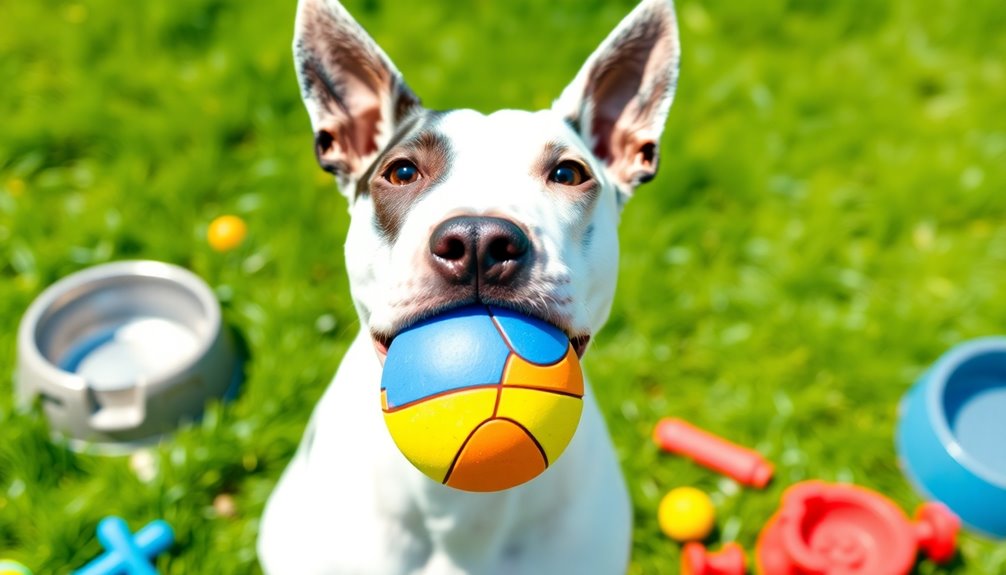
Caring for a Bull Terrier involves understanding their unique needs, from their minimal grooming requirements to their high energy levels. You'll want to ensure they get plenty of exercise and a balanced diet tailored to their specific nutritional needs. Regular exercise, typically requiring 1 to 2 hours daily, is essential to manage their high spirits and energy levels.
Minimal Brushing Required
Brushing your Bull Terrier isn't a chore; it's a simple task that keeps their coat healthy and shiny. You only need to brush them once or twice a week to maintain that glorious coat.
Grab a rubber grooming mitt or a soft-bristle brush, as these tools work best for Bull Terriers. Start at their head and gently work your way down to the tail using short strokes in the direction of hair growth. Don't forget to pay extra attention to areas prone to matting, like behind the ears and under the legs.
After brushing, finish with a full-body stroke to help distribute those natural oils. When it's time for a bath, aim for every 6-8 weeks. Use lukewarm water and a gentle, dog-specific shampoo to keep their skin irritation-free. Rinse thoroughly, and dry them off with a towel or low-heat blow dryer. Regular grooming frequency is essential to avoid skin issues and maintain overall health.
Regular grooming doesn't end there; you'll also need to trim their nails every 3-4 weeks, clean their ears weekly, and brush their teeth 2-3 times a week.
Keeping your Bull Terrier well-groomed can be a rewarding and enjoyable experience for both of you!
Exercise requirements and energy levels
Keeping your Bull Terrier well-groomed is just part of the equation; meeting their exercise needs is equally important. These energetic dogs require 1-2 hours of exercise daily, ideally split into at least two sessions. Incorporate a mix of physical activities—like brisk walks, running, and fetch—with mental stimulation through agility training or interactive play. This balanced approach helps burn off their high energy levels effectively.
When planning your Bull Terrier's exercise routine, consider their age and health status. Puppies under six months need shorter, frequent walks focused on socialization, while older dogs may require gentler activities to match their endurance. Always consult your veterinarian to tailor the exercise appropriately. Additionally, responsible ownership is essential to ensure that your Bull Terrier's exercise routine contributes to their overall well-being.
Be mindful of weather conditions, too. Avoid exercising during the hottest parts of the day in summer to prevent heatstroke, and provide a coat in winter if needed.
Monitor your dog for signs of over-exertion, such as excessive panting or fatigue, and ensure they stay hydrated. Remember, a well-exercised Bull Terrier is a happy, well-behaved companion, so make their exercise a priority!
Feeding tips and diet recommendations
To ensure your Bull Terrier thrives, it's essential to provide a well-balanced diet that meets their specific nutritional needs. Focus on protein sources like chicken, beef, fish, and eggs, which are vital for muscle development. If your dog has allergies, consider novel proteins such as duck or venison.
Include healthy fats, particularly omega-3 and omega-6 fatty acids from fish oil and flaxseed, to promote energy and a shiny coat. Carbohydrates from whole grains, vegetables, and fruits will support their digestive health. Essential vitamins and minerals play a crucial role in supporting their immune system and overall well-being—most quality commercial foods are fortified with these.
Establish a consistent feeding schedule, ideally two meals daily for adults, adjusting for puppies as needed. Control portions based on your Bull Terrier's age, size, and activity level to prevent obesity. Always provide access to clean water to support digestion and kidney health.
Lastly, keep an eye on special dietary needs. Consider supplements for joint health and consult your vet before introducing any new foods or diets to ensure you're meeting their unique requirements.
Training and Socialization
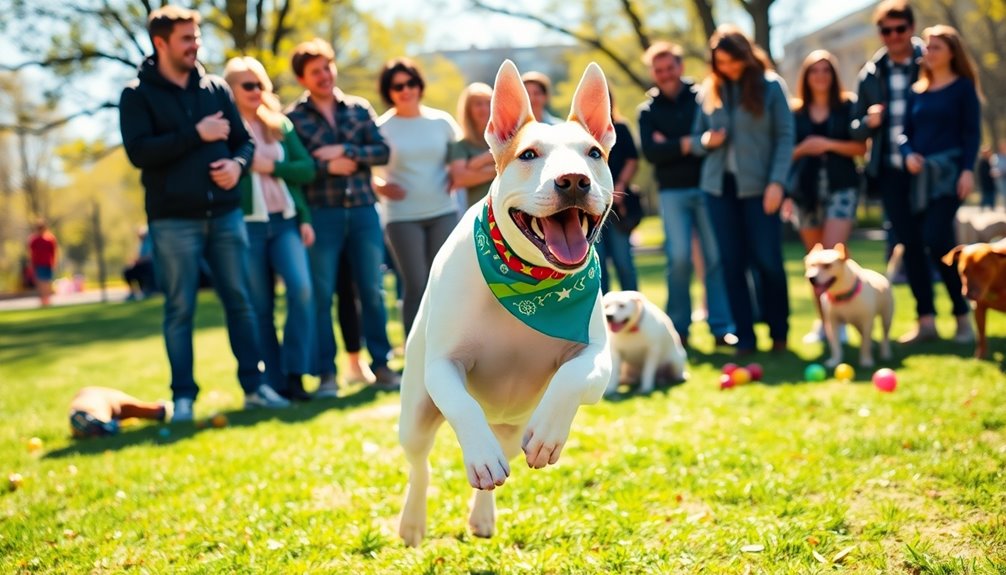
Training a Bull Terrier requires a moderately stubborn approach, as they can be quite headstrong. It's essential to introduce them to diverse environments early on to build their confidence and social skills. Additionally, focusing on impulse control can help you manage their energetic behavior effectively. Incorporating early socialization into their training routine will enhance adaptability and reduce future behavioral issues.
Moderately Stubborn Training Approach
When working with Bull Terriers, a moderately stubborn training approach is essential for success. These dogs thrive on consistency, so make sure everyone in your household uses the same commands and rewards. Establish clear guidelines from the start and dedicate a little time each day to training. This daily practice will yield consistent progress.
Positive reinforcement is your best friend. Reward desired behaviors with praise, treats, or playtime. Start by using treats, but once your Bull Terrier understands the commands, transition to other rewards like toys. Always encourage eye contact and engagement during walks and play to strengthen your bond.
Keep training sessions short and engaging, around 10-15 minutes, two to three times a day. Begin with easy commands and end on a high note to keep your dog motivated. If your Bull Terrier seems bored, accelerate the pace; if they're overly excited, slow it down.
Avoid harsh training methods like prong or choke collars, as they can lead to negative outcomes. Engaging in interactive games like tug of war can help maintain focus and interest, making training both fun and productive. Additionally, remember that Bull Terriers are known for their playful demeanor, which can enhance your training experience.
Introduce to Diverse Environments
Introducing your Bull Terrier to diverse environments is crucial for their overall adaptability and confidence. Start by taking them to parks, urban areas, beaches, and the countryside to help them feel comfortable in various settings. Gradually expose them to different surfaces like grass, gravel, and tiles; this enhances their adaptability.
Visit pet-friendly cafes, parks, or stores, allowing your Bull Terrier to experience new sights, sounds, and smells. Use positive reinforcement, such as treats and praise, to create positive associations with these new environments. Always monitor their body language for signs of stress or discomfort, adjusting exposure as needed. Regular exercise is also vital for their physical and mental well-being, as it helps them cope with new experiences.
Socialization in public places is equally important. Take your Bull Terrier to pet stores and outdoor cafes, ensuring all interactions with people and other animals are supervised.
Expose them to diverse individuals of all ages and backgrounds to foster well-rounded socialization. Use verbal cues and body language to guide their behavior, and always end these sessions on a positive note to keep their enthusiasm alive.
Impulse Control Training Challenges
Navigating the challenges of impulse control with your Bull Terrier can feel overwhelming at times, but breaking it down into manageable steps makes it achievable. Start by minimizing distractions during training and gradually introduce more as your dog improves. Identify specific areas where your Bull struggles, like waiting for food or toys, and dedicate more than 50% of your training time to those challenges. Incorporate impulse control exercises into daily activities. For example, practice calm behavior during walks, greetings, and while passing through narrow spaces. Teaching commands like "sit" can help promote calmness and control. Reward your dog for exhibiting calm behavior and consistently correct improper actions. Impulse control is crucial for a well-behaved dog and affects all aspects of your Bull Terrier's life.
Socialization plays a huge role in impulse control. Ensure controlled interactions with other dogs and people, focusing on positive experiences. Use bite inhibition during play to manage impulsive behaviors. Lastly, maintain a calm tone of voice to prevent unnecessary excitement and reinforce impulse control during everyday situations, like not pulling on the leash.
Ideal Living Environment
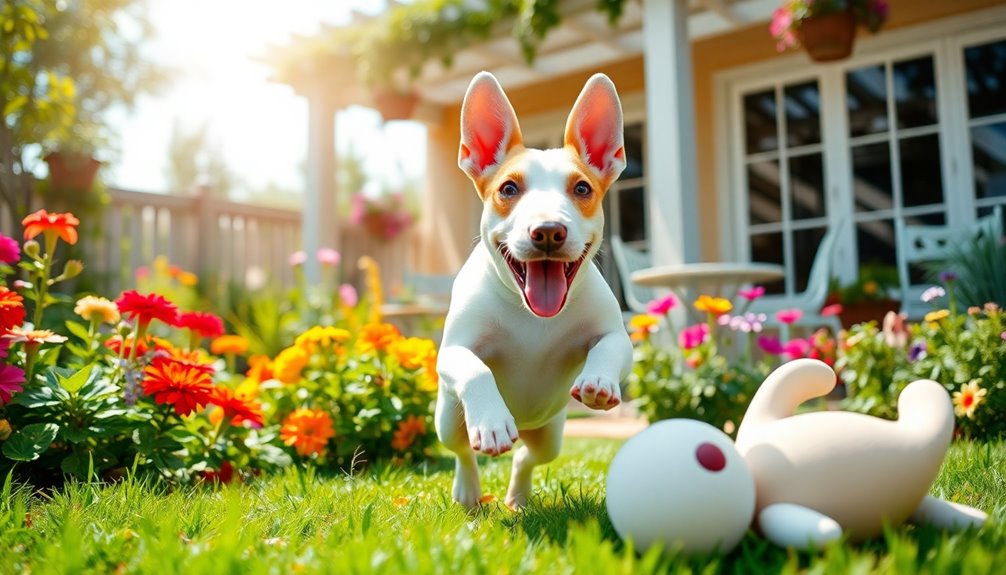
If you're considering a Bull Terrier, an urban apartment with outdoor access can work well, provided you meet their needs.
These dogs thrive in moderate temperatures, so keeping them comfortable is essential. Additionally, providing healthy dog snacks can promote overall health and wellness.
You'll need to ensure they get plenty of exercise and social interaction to keep them happy and healthy. Regular daily walks and play sessions are crucial for their well-being.
Urban Apartment With Outdoor Access
An urban apartment with outdoor access is an ideal living environment for a Bull Terrier, ensuring they get the exercise and mental stimulation they need. These energetic dogs require at least 1-2 hours of vigorous exercise daily, so having a nearby park or yard makes it easier for you to meet their activity needs. Regular walks, play sessions, and interactive games will keep your Bull Terrier physically fit and mentally engaged, preventing boredom and destructive behavior. Additionally, because of their moderate energy levels, they can adapt well to a smaller living space as long as their exercise needs are met.
In an apartment, space management is crucial. While Bull Terriers don't need a mansion, they do need enough room to move around comfortably. A clutter-free living space allows them to play without risk of accidents. It's also important to create a dedicated area for resting and playing.
Early socialization is essential, especially in close living quarters. Exposing your dog to various people and pets will help them develop into a well-adjusted adult.
Consistent training and clear rules will enable you to manage their sometimes stubborn behavior. With the right environment, your Bull Terrier can thrive in an urban apartment setting, bringing joy and laughter to your home.
Prefers Moderate Temperature Ranges
While Bull Terriers can adapt to various climates, they truly thrive in moderate temperature ranges. Ideally, you should keep their living environment between 68 and 72 degrees during winter and 75 to 78 degrees in summer. These temperatures ensure your Bull Terrier stays comfortable and healthy. Regularly monitoring indoor temperature is crucial to maintaining their comfort level.
In colder weather, remember that Bull Terriers lack an undercoat, making them vulnerable to the chill. Prolonged exposure can lead to hypothermia or frostbite, so limit outdoor time and provide warm clothing like dog coats when you venture outside. A cozy, draft-free sleeping area is crucial for their comfort.
On the flip side, if you live in hotter climates, your Bull Terrier requires special care to avoid overheating. Always provide access to shade, fresh water, and a cool resting spot. Schedule exercise for the cooler parts of the day, and keep an eye out for signs of heatstroke, like excessive panting or lethargy.
Distinctive Egg-Shaped Body
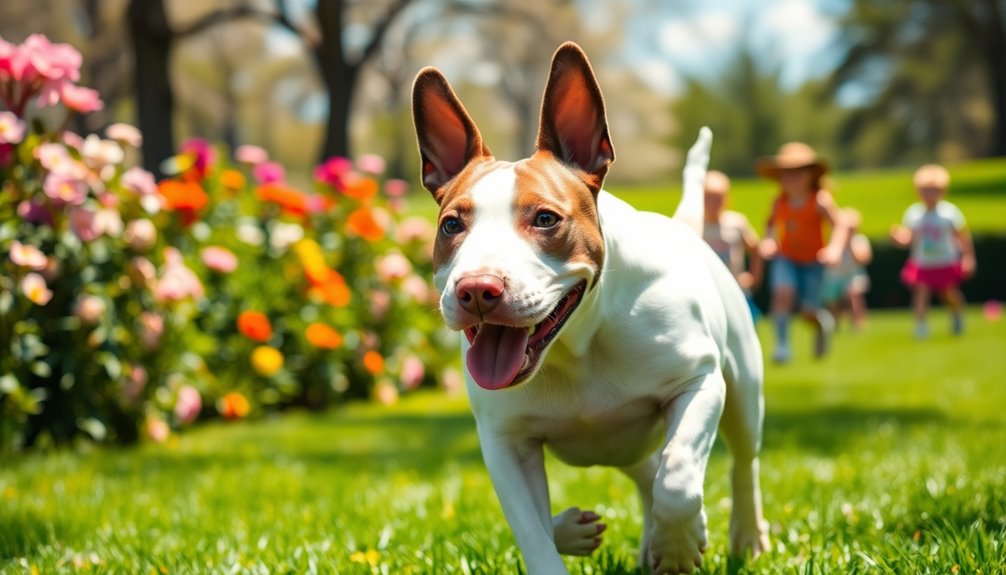
When you think of a Bull Terrier, that distinctive egg-shaped body instantly comes to mind.
This unique shape not only sets them apart visually but also influences how they communicate—these dogs rarely bark, opting for other forms of expression. Their muscular build complements their playful personality, making them both strong and energetic companions.
With their iconic look, Bull Terriers, like Spuds Mackenzie, have become memorable mascots in popular culture.
Rarely Barks, Communicates Differently
Bull Terriers may not bark as much as other breeds, but they've got a unique way of communicating that's just as effective. Instead of relying on vocalizations, they express themselves through body language and visual cues. You'll notice their ear positions, tongue movements, and overall silhouette play crucial roles in conveying emotions.
If they avoid eye contact, they're likely being submissive, while a steady stare can be quite intimidating. These dogs often grumble and groan, using these sounds to express themselves without the typical barking. Their playful demeanor shines through their antics, as they engage in fun behaviors to grab your attention. Additionally, their social cohesion is maintained through close contact and interaction, making physical affection an important part of their communication style.
When they're feeling possessive over toys or food, you might see them display dominance through body language rather than growling. Physical touch is also vital for Bull Terriers, although they prefer it on their terms. Observing their comfort levels with human interaction helps you understand their needs better.
Spuds Mackenzie, Iconic Mascot
Spuds MacKenzie, the iconic mascot of Bud Light, captured the hearts of many in the late 1980s with her distinctive egg-shaped body and playful personality.
Created by 23-year-old art director Jon Moore, Spuds made her debut during Super Bowl XXI in 1987, thanks to the Chicago advertising agency Needham Harper & Steers. While you might've thought Spuds was a male dog, the truth is she was a female Bull Terrier named Honey Tree Evil Eye, or "Evie" for short.
With a unique spot over her left eye, Evie brought life to all the ads and public appearances. The campaign is credited with a 20% sales increase for Bud Light from 1987 to 1988, showcasing the power of effective advertising strategies in driving product sales.
The Spuds MacKenzie campaign skyrocketed Bud Light sales by 20% between 1987 and 1988, producing over 200 officially licensed items, from posters to plush toys. Spuds became a pop culture phenomenon, embodying the "Original Party Animal" persona.
However, the campaign raised concerns about targeting children with alcohol marketing, leading to its end in 1989.
Even after her passing in 1993, Evie's legacy as Spuds MacKenzie remains a memorable piece of 1980s pop culture, symbolizing the fun and lively spirit of the era, much like the ongoing breast cancer awareness campaigns that continue to inspire and educate the public.
Active Lifestyle Compatibility
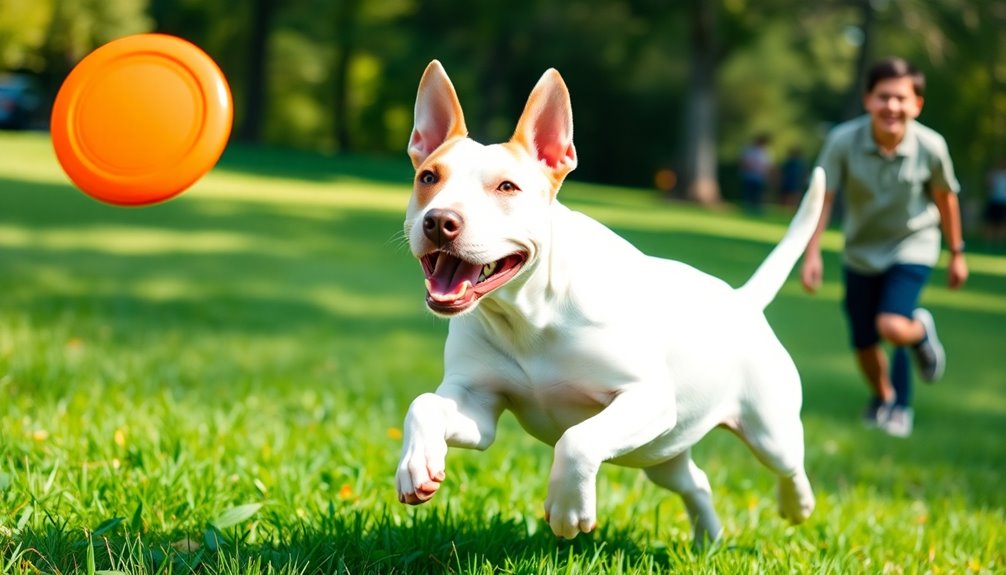
If you lead an active lifestyle, a Bull Terrier could be the perfect companion for you. Their energy levels demand regular exercise and socialization, making them great partners for outdoor adventures. Additionally, engaging in activities together can enhance cognitive development and strengthen your bond. However, you'll need to be prepared for the challenges of keeping them engaged and well-socialized. Regular exercise is essential to maintain their health and prevent obesity issues.
Energetic Companions for Active Owners
For those who lead an active lifestyle, having a Bull Terrier as a companion can be a perfect match. These energetic dogs require 1-2 hours of exercise daily, so you'll find plenty of opportunities to stay active together.
Start with brisk walks of at least 30 minutes and consider incorporating shorter, high-energy activities like running or games of fetch and tug-of-war. It's worth noting that regular exercise can also help prevent behavioral issues related to excessive energy.
To keep your Bull Terrier engaged, mix physical exercise with mental stimulation through advanced obedience training and interactive puzzle toys. It's important to ensure that these dogs receive adequate exercise to prevent behavioral issues caused by boredom.
Balance high-energy play with rest periods to avoid overstimulation, especially for younger or older dogs.
No matter your living situation, Bull Terriers adapt well, thriving in apartments or homes as long as you provide the necessary exercise.
Just remember to adjust routines based on weather conditions and your dog's age or health.
Socialization Needs and Challenges
Socialization is crucial for Bull Terriers, especially if you lead an active lifestyle. Start socializing your pup between 3 to 14 weeks old to take advantage of their sensitive learning period. Enroll in reputable puppy classes where they can safely interact with other dogs.
Expose your Bull Terrier to a variety of environments like parks, urban areas, and beaches, as this helps them adapt to different situations. It's vital to introduce your puppy to people of all ages, sizes, and backgrounds while ensuring these experiences are positive and rewarding. Consistency in socialization techniques is key to achieving the best outcomes.
Handle their paws, ears, and mouth gently to prepare them for grooming and vet visits. Familiarize them with household noises and various surfaces to build their confidence.
Set up playdates with other friendly pets and supervise interactions to prevent any negative experiences. Teach bite inhibition through gentle play and redirect any nipping to toys.
Avoid common mistakes like ignoring fear signals or inconsistent socialization efforts. By providing a well-rounded socialization experience, you'll help your Bull Terrier thrive in an active lifestyle, ensuring they're a fun and well-adjusted companion.
Frequently Asked Questions
Do Bull Terriers Get Along With Other Pets?
Bull Terriers can get along with other pets, but it depends on early socialization and supervision.
If you introduce them to other animals when they're young, they may adjust well.
However, keep in mind they can be territorial and playful, which might lead to conflicts.
Always monitor interactions, especially with small pets or young children, to ensure everyone stays safe.
Proper training and boundaries are key to harmonious multi-pet households.
How Much Exercise Do Bull Terriers Need Daily?
Bull Terriers need about one to two hours of exercise daily.
You should split this into at least two sessions, ideally around 90 minutes of walking divided into three parts for adults.
Puppies under six months require shorter, frequent walks totaling 30-40 minutes.
For senior dogs, adjust walks based on their comfort and endurance.
Incorporate brisk walks, games, and interactive play to keep them physically and mentally stimulated.
Are Bull Terriers Good Family Dogs?
Yes, Bull Terriers can be great family dogs! Their friendly and affectionate nature makes them wonderful companions for kids.
They love to play and keep active, which suits energetic families perfectly. However, you'll need to ensure they're properly socialized and trained to manage their strong-willed tendencies.
With consistent guidance and supervision during playtime, they can form strong bonds with every family member and become a loyal part of your household.
What Is the Average Lifespan of a Bull Terrier?
The average lifespan of a Bull Terrier ranges from 11 to 14 years, with some living up to 15 years.
Factors like genetic health, environmental conditions, and quality of care significantly influence their longevity.
You should be aware that white Bull Terriers may have shorter lifespans due to genetic issues.
Regular veterinary check-ups, a balanced diet, and good socialization can help you ensure your Bull Terrier lives a long, healthy life.
Do Bull Terriers Shed a Lot?
Bull Terriers are considered average shedders, so you can expect some hair around your home.
They shed year-round, with heavier shedding during seasonal changes, like winter and summer.
Genetics, health, and environment influence their shedding patterns.
To manage it, brush your Bull Terrier regularly and maintain a healthy diet and stress-free living space.
If you notice excessive shedding or skin issues, it's best to consult your vet for advice.
Conclusion
In conclusion, the Bull Terrier truly embodies the spirit of a playful companion. With their unique egg-shaped body and lively personality, they bring joy and laughter to any home. By providing proper training, socialization, and an active lifestyle, you'll ensure your Bull Terrier thrives as a happy, healthy member of your family. If you're looking for a loyal friend who's always up for fun, this breed is definitely the clown you'll want by your side!

